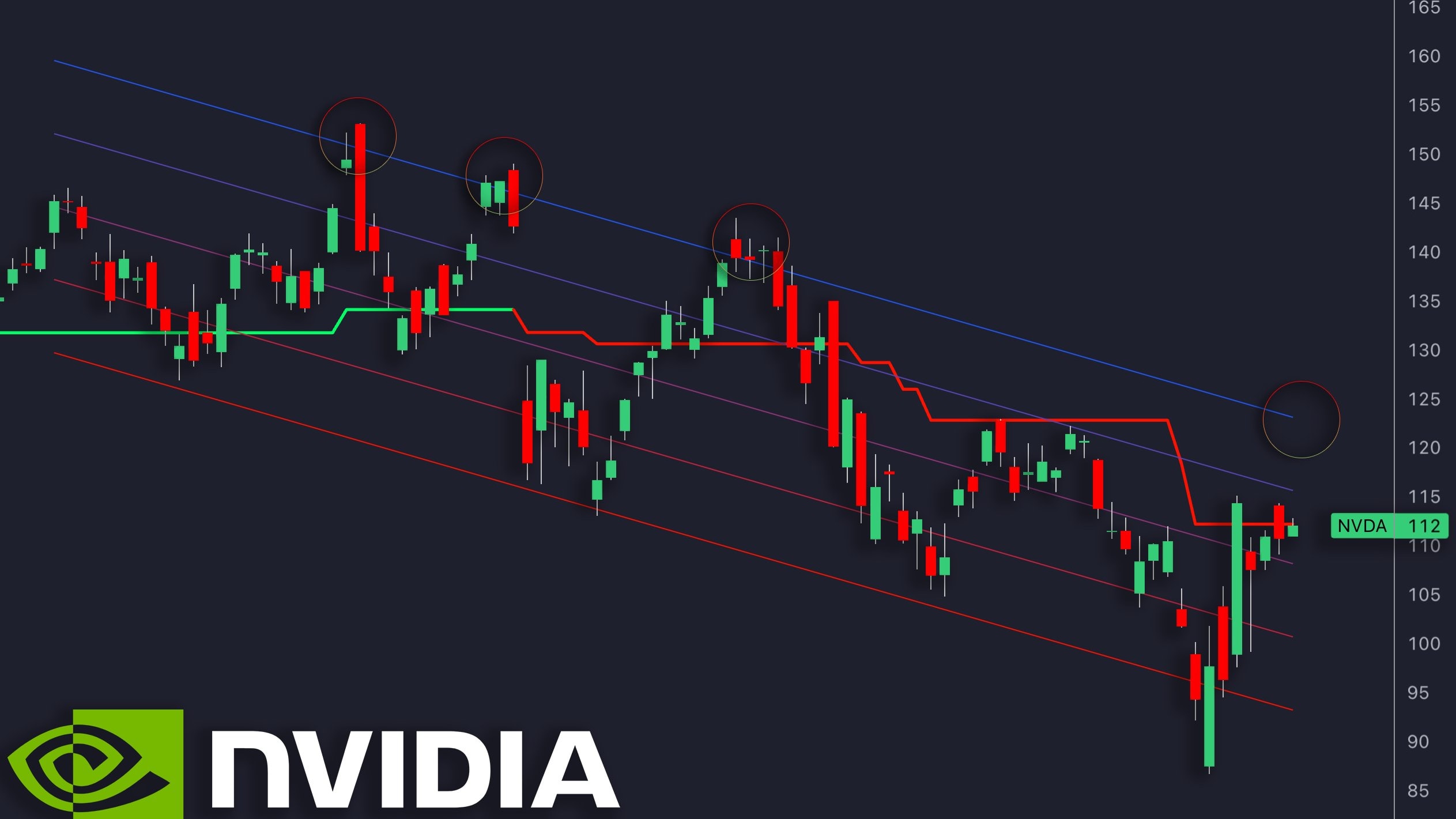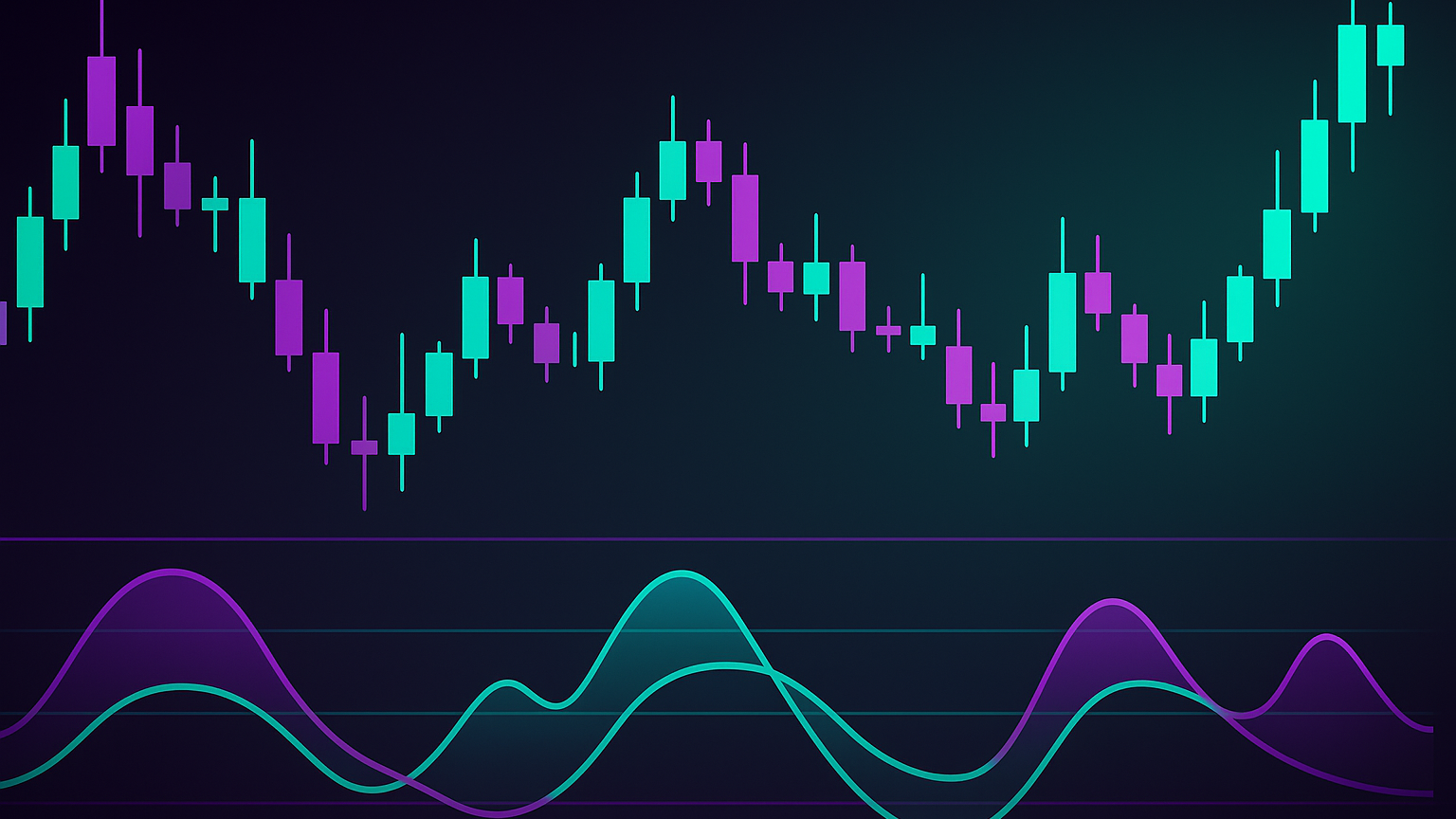Explore the Linear Regression Indicator, a dynamic tool for tracking price trends and enhancing trading strategies with real-time data analysis.
The Linear Regression Indicator (LRI) is a trading approach that uses statistical methods to track price trends and estimate potential movements. Unlike static trend lines or moving averages, the LRI dynamically adjusts to price changes, offering traders a real-time view of market direction. It calculates a trend line using least squares regression over a set period, updating with each new price bar. For background on the math, see an overview of the least‑squares method.
Key Takeaways:
- What It Does: Tracks price trends by fitting a regression line to historical data.
- How It Works: Uses least squares regression to minimize the distance between prices and the trend line.
- Benefits: Provides clear trend signals, entry/exit points, and adapts across timeframes.
- Challenges: Can produce false signals in sideways markets or lag during rapid price shifts.
The LRI is most effective when combined with tools like volume analysis, oscillators (RSI, MACD), or regression channels. It helps traders identify trends, reversals, and momentum shifts while offering actionable insights for risk management and strategy refinement.
How the Linear Regression Indicator Works
Fitting a Trend Line to Price Data
The Linear Regression Indicator relies on a mathematical method called least squares regression to fit a trend line through historical price data. This technique calculates the line that best represents the relationship between price movements and time over a specific period, which typically ranges from 14 to 50 bars, depending on your trading timeframe.
Here’s how it works: the indicator takes the closing prices from your chosen lookback period and plots them against time. It then determines the straight line that minimizes the distance between all the price points and the line itself. This process results in a trend line that optimally reflects the underlying price movement.
As new bars are added, the calculation updates by dropping the oldest price and including the newest. This rolling update ensures the trend line stays current, maintaining accuracy while adapting to recent market activity.
These mechanics lay the groundwork for understanding the key components of the indicator.
Key Components: Slope and Position
The effectiveness of the Linear Regression Indicator comes down to two main factors: the slope of the regression line and its position relative to current prices.
- Slope reflects the trend’s direction and intensity. A positive slope signals bullish momentum, while a negative slope indicates bearish pressure. The steeper the slope, the stronger the trend. Conversely, a flatter slope suggests sideways movement or a weakening trend. A change in slope can hint at potential trend reversals—for instance, a shift from a negative to a positive slope might indicate a move from bearish to bullish conditions.
- Position relative to price offers additional insight. When prices are above the regression line, it often suggests bullish conditions or possible overvaluation. Prices below the line may indicate bearish conditions or undervaluation. Significant deviations from the line can point to overextensions, which might lead to either momentum continuation or a reversal toward the trend line.
Linear Regression Line vs. Channel
Unlike a manually drawn regression line, the Linear Regression Indicator continuously updates itself to reflect the latest market data.
The Linear Regression Indicator automatically calculates and plots the endpoint of the regression line for each bar, creating a dynamic trend line that adjusts in real-time without the need for manual input.
The Regression Channel builds on this concept by adding parallel lines above and below the main regression line. These additional lines are typically set at one or two standard deviations from the central line, creating a channel that encompasses most price movements. This feature helps traders identify potential support and resistance levels at the channel’s boundaries.
Practical Applications:
- Use the Linear Regression Indicator for ongoing trend analysis that updates automatically, making it ideal for trend-following strategies where the focus is on the direction and strength of the trend.
- Opt for the Regression Channel when identifying potential reversal zones or gauging whether prices are trading at statistical extremes. This is particularly useful for mean reversion strategies, where the expectation is that prices will move back toward the central regression line after reaching the outer edges of the channel.
How to Apply the Linear Regression Indicator
How to Add and Configure the Indicator
To get started, choose a trading platform that supports the Linear Regression Indicator. Platforms like TradingView, MetaTrader, NinjaTrader, and Thinkorswim include built-in versions. However, LuxAlgo provides enhanced versions with added features and customization options.
Adding LuxAlgo Linear Regression tools on TradingView:
Open your TradingView chart and click the indicators button at the top. In the search bar, type "LuxAlgo" and select the specific indicator you want. LuxAlgo provides two key Linear Regression tools: "Periodic Linear Regressions [LuxAlgo]" and "Linear Regression Fan [LuxAlgo]". Choose your preferred tool and add it to your chart.
Configuring the Periodic Linear Regressions Indicator:
Once the indicator is added, adjust its settings to suit your trading strategy. The Method option lets you switch between Static (which recalculates at the end of a period) and Rolling (which updates continuously with each new bar). The Anchor Type determines whether calculations are based on periodic intervals or start from the first bar of your selected timeframe.
For the Anchor Period, use 14–20 bars for day trading or 50–100 bars for swing trading. Adjust the Multiple setting to control the regression band's width—higher values create wider channels to capture larger price movements.
Configuring the Linear Regression Fan:
For the Fan indicator, set the Length parameter to define the lookback period. The default is often 50 bars, but you can adjust this between 14 and 300 depending on your approach. The Mult (multiplier) setting adjusts the fan's width, with higher values creating broader fans to capture more extreme price movements.
The Lines Per Side option determines the number of regression lines displayed above and below the central line. Keeping this at 2–3 lines per side provides enough detail without overwhelming the chart.
Once configured, these indicators provide actionable signals for identifying trends and reversals.
Reading Signals for Trends and Reversals
Accurately interpreting Linear Regression signals is key to effective trading. These signals generally fall into three categories: trend confirmation, reversal warnings, and momentum shifts.
Trend Confirmation Signals:
When prices stay above an upward-sloping regression line, it confirms bullish momentum. Larger gaps between price and the line indicate stronger trends, while prices closer to the line suggest weakening momentum. For bearish trends, look for prices consistently below a downward-sloping regression line.
The slope angle is also important. Steeper slopes indicate stronger trends, while flattening slopes suggest potential trend exhaustion. A change from steep to gradual often signals an upcoming consolidation or reversal.
Reversal Warning Signals:
Regression channel boundaries can highlight potential reversals. However, in strong trends, prices can remain "overbought" or "oversold" for longer than expected. Use additional tools to confirm these signals.
Momentum Shift Recognition:
Price crossovers with the regression line often signal momentum changes. For example, if prices cross above the regression line after being below it, this indicates growing bullish pressure. Conversely, crossing below the line after trading above it suggests bearish momentum.
These signals become stronger when combined with slope changes. For instance, a price crossing above a regression line while the slope shifts from negative to positive provides a stronger bullish signal.
To refine these interpretations further, consider integrating additional tools into your analysis.
Combining with Other Tools for Better Results
Linear Regression indicators become even more effective when paired with complementary tools that confirm signals and reduce false positives. These combinations enhance your ability to identify high-probability setups.
Pairing with LuxAlgo's Price Action Concepts:
The Price Action Concepts (PAC) toolkit works seamlessly with regression analysis. For example, if a price approaches the upper regression channel boundary while PAC identifies a bearish order block at the same level, this alignment suggests a strong reversal opportunity. This combination uses regression for statistical insight and PAC for market logic.
Integration with Traditional Oscillators:
Combine regression analysis with oscillators like RSI and MACD to validate trend strength. If prices reach regression channel extremes, check the RSI for overbought (above 70) or oversold (below 30) conditions. This helps differentiate between temporary pullbacks and actual trend reversals.
MACD crossovers can also confirm regression signals. For instance, if prices cross above the regression line and the MACD crosses above its signal line simultaneously, the bullish signal gains credibility.
Volume Analysis Enhancement:
Adding volume analysis helps confirm the strength of price movements. A breakout above the regression channel with high volume suggests genuine momentum, while low-volume breakouts often result in false signals.
LuxAlgo's Signals & Overlays simplifies volume analysis by identifying anomalies that coincide with regression line interactions. This helps distinguish reliable setups from potential traps.
Multi-Timeframe Confirmation:
Analyzing Linear Regression across multiple timeframes strengthens signal accuracy. For example, if the daily chart shows prices nearing the upper regression channel and the 4-hour chart indicates a bearish slope change, the alignment increases the likelihood of a reversal.
LuxAlgo’s tools allow for consistent analysis across timeframes, making it easier to spot these confluences without manual adjustments.
Trading Strategies with the Linear Regression Indicator
Finding Entry and Exit Points
The Linear Regression Indicator can help traders identify when to enter and exit trades by analyzing price crossovers with the regression line. However, the context surrounding these crossovers plays a big role in determining their reliability.
Entry Points:
For a bullish entry, look for prices to cross above the regression line when it has an upward slope. Ideally, this should happen after the price rebounds from the lower channel boundary. For bearish entries, wait for prices to cross below the regression line when it has a downward or flattening slope, following a rejection at the upper channel boundary. These setups naturally guide the exit strategies discussed below.
Exit Strategies:
A straightforward exit strategy is to target the opposite channel boundary. For instance, if you entered long near the lower boundary, aim for the upper boundary. That said, prices often reverse before reaching these extremes.
To protect gains, use the regression line as a trailing stop. For long positions, place stops below the regression line, and for short positions, place them above. If the regression line flattens or begins to change direction, consider reducing your position size or tightening stops to lock in profits before a potential reversal.
Risk Management Tips
Effective risk management is key to successfully applying these strategies.
Stop-Loss Placement:
Set dynamic stop-losses just beyond the opposite channel boundary, adjusting for market volatility using a multiplier of 1.5–2.0× the Average True Range (ATR). For long trades near the lower boundary, stops should be placed 10–15% below the boundary to account for false breakouts.
Avoiding False Signals:
Avoid trades when the regression line has minimal slope. For breakout trades, ensure trading volume is at least 20% above the 20-day average, and for channel reversals, look for volume to exceed 50% of the average. Additionally, avoid signals during the first 30 minutes after market open or the last hour before close.
Position Sizing:
If regression signals conflict across different timeframes, reduce your position size by 50%. When trading multiple assets, ensure they are not highly correlated to avoid overexposure.
Using with LuxAlgo's Toolkits

LuxAlgo provides tools that can add precision and efficiency to regression-based strategies, offering additional confirmation and automation.
Price Action Concepts (PAC):
PAC helps identify market structure breaks that align with regression channel boundaries. For example, when prices approach a boundary and PAC highlights order blocks at the same level, this alignment indicates a strong reversal setup. PAC’s Smart Money Concepts can also help interpret regression signals within the context of institutional activity.
Signals & Overlays (S&O):
S&O enhances regression strategies by providing multi-algorithm confirmations. Requiring at least two signals to align with the regression analysis can help improve trade selection. Additionally, custom alerts within S&O ensure you don’t miss setups while maintaining strict trading criteria.
Oscillator Matrix (OSC):
OSC adds a layer of momentum analysis to regression strategies. It detects divergences that often precede changes in the regression line’s slope, offering early warning signals. The toolkit also tracks money flow to help confirm whether regression breakouts have institutional support.
LuxAlgo’s AI Backtesting platform allows you to quickly test regression strategies across many scenarios. This data-driven approach helps fine-tune settings like regression periods and channel multipliers. Even after deployment, real-time optimization ensures your strategy adapts to changing market conditions. Learn more in the documentation.
Market Screening Features:
LuxAlgo’s screeners can scan entire markets to find assets that meet your regression criteria. Multi-timeframe screening allows you to identify setups where regression signals align across daily, 4-hour, and 1-hour charts, increasing confidence in your trades.
LuxAlgo Linear Regression Histogram (Free)

The Linear Regression Histogram helps you discover zones of interest within a trend by counting how often price falls into equally spaced intervals (bins) across a linear regression channel. In practice, this reveals price areas that see repeated interaction—useful when locating potential support/resistance while a trend is in play.
How it works: the indicator builds a regression channel around price, then divides the channel range into bins of equal width. For each new bar, it tallies which bin price falls into and updates the histogram. Bins with notably higher counts stand out as statistically active zones that deserve attention for entries, partials, or risk placement.
Key settings: Length (regression lookback), Bins Number (how many intervals to evaluate), Mult (multiplier of the channel width, based on RMSD/RMSE), and Src (price source). For a concise code reference and parameter details, see the open-source script on TradingView.
Practical tip: use the histogram to confirm regression-channel touchpoints. When price approaches the channel boundary near a high-count bin, it often marks a locally important region—combine with PAC structure levels or S&O confirmations for higher conviction.
$1Pros and Cons of the Linear Regression Indicator
Main Benefits of the Indicator
The Linear Regression Indicator offers traders a structured way to interpret market trends and set actionable price targets.
Trend Clarity and Direction: By cutting through market noise, this indicator provides a clear view of trend direction, steering traders away from the confusion often caused by moving average whipsaws. (For background on regression, see regression analysis.)
Objective Price Targets: The channel boundaries set by the indicator offer clear entry and exit points. These levels aren’t random; they’re grounded in statistical relationships derived from price data, giving traders a solid foundation for decision-making.
Works Across Timeframes: Whether you're an intraday scalper or a long-term position trader, this indicator adapts well. For instance, a 20-period regression on a daily chart can highlight weekly trends, while the same setting on a 5-minute chart can guide short-term trades. This flexibility allows traders to use a consistent approach, regardless of their trading style.
Early Reversal Signals: When paired with volume analysis, the Linear Regression Indicator can hint at potential trend reversals before they become evident to most traders. For example, price rejections at the channel boundaries, especially when accompanied by changes in the slope of the regression line, often signal significant moves in the opposite direction.
Common Drawbacks and Challenges
While the indicator has its strengths, it’s not without its challenges, and traders should be aware of its limitations.
Challenges in Volatile or Trending Markets: In highly volatile or strongly trending markets, the indicator may lag. This delay can result in missed reversals or incorrect positioning, especially when markets experience rapid shifts or significant price gaps.
False Signals in Sideways Markets: When prices move sideways, the regression line often flattens, leading to frequent false signals as prices oscillate around it. This is particularly problematic in low-volatility environments where meaningful trends are absent.
Sensitivity to Period Settings: The indicator’s performance heavily depends on the chosen regression period. Shorter periods react quickly but can produce noisy signals, while longer periods smooth out trends but may overlook short-term opportunities. Finding the right balance can be a constant challenge for traders.
Risk of Overreliance: Solely relying on this indicator without considering the broader market context can be risky. Factors like economic events, earnings reports, or geopolitical developments can temporarily overshadow technical signals, leaving traders vulnerable if they ignore these external influences.
Comparison Table: Pros and Cons
| Advantages | Limitations |
|---|---|
| Clear trend identification through statistical methods | Lagging signals during rapid market shifts |
| Objective price targets from channel boundaries | False signals in sideways, low-volatility markets |
| Versatility across timeframes for different trading styles | Period sensitivity requiring careful adjustment |
| Early reversal signals when paired with volume analysis | Overreliance risk without considering external factors |
| Noise reduction compared to moving averages | Extended boundary breaks in strong trends |
| Consistent approach across various markets | Limited relevance during news-driven volatility |
Conclusion
Key Takeaways
The Linear Regression Indicator simplifies price trends by cutting through market noise with mathematical accuracy. The regression line highlights recent price movements, while the channel boundaries provide clear entry and exit points based on statistical relationships.
By combining this approach with proper position sizing and well-placed stops, traders can enhance trend identification and risk management. The channel boundaries suggest logical areas for stop-loss placement, while shifts in the slope can hint at weakening momentum before it's evident in price action. Its flexibility across various timeframes ensures it’s effective for both day traders and swing traders.
For best results, pair this indicator with volume analysis, key support and resistance levels, and the broader market context. Keep in mind, external factors like economic events or geopolitical developments can temporarily override technical signals, making situational awareness essential for effective trading.
Use these insights to refine your strategy by testing and integrating the indicator into your trading plan.
Next Steps for Traders
Start by incorporating the Linear Regression Indicator into your current setup. A 20-period setting is a good starting point, but be prepared to adjust based on market conditions. Shorter periods can react faster but might generate false signals, whereas longer periods smooth out trends but could miss short-term opportunities.
- Optimize settings: Use LuxAlgo’s AI Backtesting to fine-tune regression period settings for different market conditions. This data-driven approach eliminates guesswork and provides clarity on performance across various scenarios.
- Enhance precision: Combine the indicator with LuxAlgo’s toolkits. The Price Action Concepts toolkit helps identify support and resistance levels that align with regression channel boundaries, while the Signals & Overlays toolkit confirms key price levels.
- Leverage screeners: Use LuxAlgo screeners to identify assets where the Linear Regression Indicator shows strong trend signals. These screeners filter thousands of instruments to highlight those respecting channel boundaries or showing breakout potential.
- Connect with others: Join the LuxAlgo community to exchange ideas and learn from other traders.
Linear Regression: Indicator Explained — How to Exploit It in a Trading System
FAQs
How does the Linear Regression Indicator differ from traditional moving averages for identifying trends?
The Linear Regression Indicator tends to respond faster than traditional moving averages when it comes to spotting trends. This is because it applies a statistical method to create a trend line that minimizes the distance from all price points, allowing it to detect shifts in market direction more quickly.
Unlike moving averages, which average out data over a set period, the Linear Regression Indicator zeroes in on the slope of the trend and its intensity. This level of detail makes it particularly useful for traders aiming to identify potential trend reversals or confirm the market's direction with more precision.
How can I set the regression period to balance responsiveness and accuracy in trend analysis?
When setting the regression period for a linear regression indicator, finding the right balance between responsiveness and accuracy is crucial. This choice depends on your trading objectives and the current market environment.
- Shorter periods (like 20–50) make the indicator more reactive to recent price changes. This can help spot quick shifts in the market but often comes with the downside of generating more false signals.
- Longer periods (such as 100–200) create smoother and more consistent trend lines. While they’re less likely to produce misleading signals, they might lag behind in fast-moving markets.
A 50-period setting is a practical starting point for many traders, offering a middle ground that works well in various scenarios. From there, you can tweak the period to fit your trading timeframe and how volatile the market is. Experimenting with different settings will help you fine-tune the indicator to align with your specific strategy.
How can traders use the Linear Regression Indicator with other tools to strengthen their trading strategies?
Traders can refine their strategies by pairing the Linear Regression Indicator with other tools like Bollinger Bands, moving averages, or momentum indicators such as RSI and MACD. These combinations can help confirm trends and spot potential reversals, boosting the precision of your analysis.
For instance, you might rely on the Linear Regression Indicator to gauge the overall trend direction, while an RSI indicator can signal whether the market is overbought or oversold. Bollinger Bands, on the other hand, can shed light on price volatility, helping you pinpoint entry and exit opportunities. By blending these tools, traders can create a more comprehensive and balanced approach to navigating markets.
References
LuxAlgo Resources
- Periodic Linear Regressions — Indicator
- Linear Regression Fan — Indicator
- Linear Regression Histogram — Indicator
- Trend Lines — Indicator
- Historical Price Projection — Indicator
- Volumetric Toolkit — Indicator
- Regression Channel — Indicator
- Support & Resistance Dynamic — Indicator
- Fibonacci Exhaustion — Indicator
- Fibonacci Trailing Stop — Indicator
- Range Average Retest Model — Indicator
- Breakouts with Tests & Retests — Indicator
- Volume Forecasting — Indicator
- Money Flow Profile — Indicator
- Price Action Concepts — Indicator
- Adaptive Momentum Oscillator — Indicator
- RSI Multi‑Length — Indicator
- AI Backtesting Assistant — Platform
- Oscillator Matrix — Reversal Signals (Docs)
- Price Action Concepts — Introduction (Docs)
- AI Backtesting Assistant — Documentation
- Understanding Moving Averages — Blog
- Smart Money Concepts Indicator — Blog
External Resources
- TradingView — Charting Platform
- Linear Regression Histogram [LuxAlgo] — TradingView Script
- Relative Strength Index (Wikipedia)
- MACD (Wikipedia)
- Bollinger Bands (Wikipedia)
- Least Squares Method (Investopedia)
- Standard Deviation (Investopedia)
- Average True Range (Investopedia)
- Regression Analysis (Investopedia)








